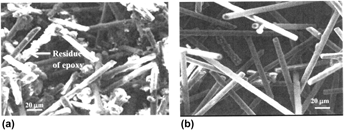Crossref Citations
This article has been cited by the following publications. This list is generated based on data provided by
Crossref.
Wang, Huaiyuan
Wang, Rui
Wang, Chao
Li, Meiling
and
Zhu, Yanji
2017.
Influence of fiber orientation on the tribological properties of unidirectional carbon fiber reinforced epoxy composites corroded by 10 wt% sulfuric acid solution.
Journal of Materials Research,
Vol. 32,
Issue. 4,
p.
801.
Lin, Leyu
and
Schlarb, Alois K.
2019.
Recycled carbon fibers as reinforcements for hybrid PEEK composites with excellent friction and wear performance.
Wear,
Vol. 432-433,
Issue. ,
p.
202928.
Dvořáčková, Štěpánka
and
Kroisová, Dora
2020.
Thermal Expansion of Composite System Epoxy Resin/Recycled Carbon Fibers.
Materials Science Forum,
Vol. 994,
Issue. ,
p.
162.
May, D.
Goergen, C.
and
Friedrich, K.
2021.
Multifunctionality of polymer composites based on recycled carbon fibers: A review.
Advanced Industrial and Engineering Polymer Research,
Vol. 4,
Issue. 2,
p.
70.
Zou, Bin
Qiu, Shuilai
Qian, Ziyan
Wang, Jingwen
Zhou, Yifan
Xu, Zhoumei
Yang, Wenhao
and
Xing, Weiyi
2021.
Phosphorus/Nitrogen-Codoped Molybdenum Disulfide/Cobalt Borate Nanostructures for Flame-Retardant and Tribological Applications.
ACS Applied Nano Materials,
Vol. 4,
Issue. 10,
p.
10495.
Lin, Leyu
Zhao, Yuxiao
Xu, Yao
Sun, Chong
and
Schlarb, Alois K.
2022.
Advanced recycled carbon fiber (rCF) reinforced PEEK composites – excellent alternatives for high-performance tribomaterials.
Materials Today Sustainability,
Vol. 20,
Issue. ,
p.
100227.
Ventura, Alejandra M.
Kneissl, Lucas M.
Nunes, Stephanie
and
Emami, Nazanin
2022.
Recycled carbon fibers as an alternative reinforcement in UHMWPE composite. Circular economy within polymer tribology.
Sustainable Materials and Technologies,
Vol. 34,
Issue. ,
p.
e00510.
Wu, Yuanyuan
Gao, Qian
Chen, Beibei
Wan, Yi
Huang, Weizhao
Tong, Xiaohang
Gu, Bohong
and
Takahashi, Jun
2023.
Impact and Flexural Energy Absorption Mechanism of Hybrid Composites Interleaved CF/PA6 Fiber Papers Based On Real-Time Cracks Tracking.
Applied Composite Materials,
Ateeq, Muhammad
Shafique, Muhammad
Azam, Anam
and
Rafiq, Muhammad
2023.
A review of 3D printing of the recycled carbon fiber reinforced polymer composites: Processing, potential, and perspectives.
Journal of Materials Research and Technology,
Vol. 26,
Issue. ,
p.
2291.
Kocoglu, Hurol
Korkusuz, Orkan Baran
Ozzaim, Pelin
Kodal, Mehmet
Altan, M. Cengiz
Sinmazcelik, Tamer
Ozcelik, Babur
and
Ozkoc, Guralp
2023.
Solid particle erosion and scratch behavior of novel scrap carbon fiber/glass fabric/polyamide 6.6 hybrid composites.
Polymer Composites,
Vol. 44,
Issue. 10,
p.
7197.
Di, Jing
Zuo, Hongliang
Li, Yishi
and
Wang, Zhaowen
2023.
Design method for glulam beams strengthened with flax fiber reinforced polymer sheets.
Structures,
Vol. 49,
Issue. ,
p.
26.
Guo, Gangjian
Chen, Joseph C.
Finkenstadt, Victoria L.
Velayudham, Lingeswar
and
Rizvi, Reza
2024.
Direct injection molding of polypropylene composites reinforced with recycled carbon fibers.
The International Journal of Advanced Manufacturing Technology,
Vol. 135,
Issue. 11-12,
p.
5353.
Soni, Ashish
Kumar Das, Pankaj
and
Gupta, Sonu Kumar
2024.
Experimental investigations on the influence of natural reinforcements on tribological performance of sustainable nanocomposites: A comparative study with polymer technology.
Tribology International,
Vol. 191,
Issue. ,
p.
109195.
Fidan, Sinan
Ürgün, Satilmiş
Bora, Mustafa Özgür
and
Özsoy, Mehmet Iskender
2025.
Scratch load and indenter type dependent scratch evaluation of milled carbon fiber filled basalt fiber/epoxy composites with factorial design.
Polymer Composites,
Vol. 46,
Issue. 3,
p.
2826.
